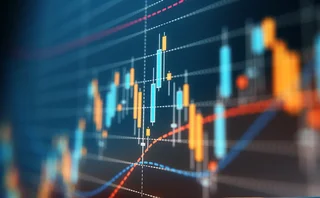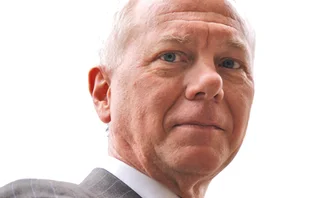
Following the paper trail
A pronounced drop in commercial paper issuance, particularly in non-financial paper, shows no signs of abating. Richard Bravo discovers what factors have led to this blockage in the supply pipeline and how companies have been – and will be – affected

Non-financial commercial paper peaked in November of 2000, when issuance reached $351.3 billion, according to Federal Reserve data. As of December 2003, that figure had been whittled away by 70% to just $105 billion. Total commercial paper levels also peaked in November of 2000 at $1.627 trillion, and have since fallen 22% to $1.265 trillion this past December.
Since the economic downturn, many companies have been able to get away with having a severe mismatch in asset liabilities on their balance sheets. While this would not necessarily pose a problem during a period of growth, a downturn in the economy and a pullback in business spending could, and did, create serious rollover risk for those corporations.
“A lot of companies were financing longer-term assets with short-term liabilities, such as commercial paper,” says Diane Vazza, head of fixed-income global research at Standard & Poor’s. “That game only works as long as there are no problems in the financial market.”
And just when the markets began unraveling, so too did the commercial paper market. Exacerbated in part by the sudden meltdowns of Enron and WorldCom, investors began reassessing their portfolios – and the balance sheets of those companies within their portfolios – in an effort to pinpoint the next credit disaster. The skepticism throughout the market community forced major debt issuers to rethink how much short-term paper they had outstanding.
In fact in March of 2002, Bill Gross, manager of Pimco, a West Coast-based fixed-income asset manager with over $350 billion under management, leveled his crosshairs on General Electric Capital, the financing unit of General Electric, concerning its heavy reliance on the short-term debt market. In a column on Pimco’s website, Gross criticized GE Capital’s $127 billion in outstanding short-term debt, which exceeded the company’s bank lines by a factor of three.
As the yields of General Electric’s securities began inching away from their counterpart securities in the Treasury market, companies across the board began repairing long-neglected balance sheets and started to term out their commercial paper into longer-dated maturities. In fact, 2002 was a phenomenal year in terms of debt supply, with $551 billion of high-grade issuance to hit the US market. And in a way, many corporations were lucky that the market conditions were amenable to their predicament.
“The markets were kind, because at that same time rates were starting to ratchet down and companies were able to restructure that mismatch in asset liabilities and refinance,” said S&P’s Vazza. “Some of the commercial paper that was financing longer-term assets has been restructured on the companies’ balance sheets. There was an opportunity in the markets and companies availed themselves of that. We are poised to rebuild.”
Since the beginning of 2001, the Federal Open Market Committee has cut its target for the federal funds rate 13 times from 6.5% to 1%, where it currently stands. This drastic drop in rates made conditions extremely favorable for companies that wanted to term out their short-term debt loads.
Further putting pressure on short-term debt issuers was investor speculation that many companies would not be able to maintain their tier 1 status in the commercial paper market. Rule 2a-7 of the Investment Company Act of 1940 stipulates that money market funds – some of the largest investors in short-term paper – are not allowed to have more than 5% of their assets in securities rated below tier 1. Hence, when companies lose their tier 1 status, they are sometimes completely shut out of the commercial paper market and have to resort to other, more expensive means of satisfying their financing needs.
Market indicator
Because corporations use commercial paper to fund daily operations, market observers look at commercial paper levels as a good leading indicator of investment spending, which can in turn spark optimism about the general health of the market. And even though capital spending started to grow again in 2002, prior to that it suffered its most devastating downturn over a two-year period since the Second World War.
Real business spending peaked in the final quarter of 2000, and then, in the nine subsequent quarters, it fell by a cumulative 12.9%, says John Lonski, chief economist at Moody’s. Since that precipitous drop, business spending has recovered by a cumulative 6.7%, which still leaves it over 6% under its zenith. And until capital spending recoups more of its losses, commercial paper levels will not be able to appreciably recover.
“Companies have plenty of cash-on-hand with which to finance capital spending,” says Lonski. “Ample amounts of cash relative to capital spending has lessened the need for commercial paper, and we are still getting the terming-out phenomenon. But that particular refinancing wave is, perhaps, drawing to a close.”
Furthermore, the dollar value of mergers and acquisition activity fell on average by 41% per year in 2001 and 2002, says Lonski, which would further explain a reduced need for short-term debt by corporations.
“I’m under the opinion that by year’s end we will see a year-over-year gain for commercial paper outstanding,” adds Lonski. “As the economic recovery proceeds, especially if real business investment grows by the expected 10.3%, and if mergers and acquisition activity begins to grow, then commercial paper outstanding should be advancing sequentially toward the middle of this year and growing toward year-end.”
In line with the rest of the credit universe, it has been extremely difficult finding value in a technical environment that has been driving spreads tighter and tighter. As of January 15, 90-day double-A non-financial commercial paper discount rates were at 0.98%, the lowest level since the Federal Reserve began compiling the data. The diminishing yield in the commercial paper market has induced investors to look further down the credit spectrum, which has resulted in a contraction in spreads between the tier 1 and tier 2 markets. At the end of 2001, the spread between tier 1 and tier 2 paper was 70 basis points, according to S&P. By the end of 2002, that spread had come in to 34 basis points. Right now, that spread stands at just nine basis points, illustrating the extent to which investors will stoop to pick up extra yield.
One of the factors that has helped to all but erase any substantive difference between the tier 1 and tier 2 markets has been the recent improvement in the credit quality of commercial paper. In 2003, for the first time in six years, the downgrade ratio of non-financial commercial paper improved, with downgrades comprising 77% of rating actions, according to S&P. The decline in credit quality reached its apex in 2002 at 92%, compared with 56% in 1997.
“Over the past year, commercial paper levels on a spread basis have been close to agencies,” says Sean Simko, portfolio manager at Weiss Peck & Greer. “ I would expect over the next six months to three quarters of a year to see some spread widening as commercial paper issuance becomes more prominent.”
Although manufacturing has been lagging behind in our current economic recovery cycle, there are signs that inventory levels and capacity utilization are on the right path, both necessary elements for commercial paper levels to pick back up. The Institute for Supply Management’s non-manufacturing index for December came in below Wall Street’s predictions, dropping to 58.6 in December from 60.1 in November. The numbers illustrate that the sector is not growing as fast as it was in prior months, but readings over 50 indicate expanding activity. Capacity utilization was at 75.7% in November and 75% in October, up from a record low of 74.2% in June of last year, according to S&P data. Capacity utilization was at a recent high of 82.8% in June of 2002.
During times of growth, capacity utilization should be at 80%, reckons S&P’s Vazza. “We are expecting to see moderate increases in capacity utilization in 2004,” she says, “which is what we need to see for commercial paper to increase, not just retail inventories but wholesale inventory and manufacturing. Until companies are convinced that there will be demand, they are not going to rebuild inventory.”
Only users who have a paid subscription or are part of a corporate subscription are able to print or copy content.
To access these options, along with all other subscription benefits, please contact info@risk.net or view our subscription options here: http://subscriptions.risk.net/subscribe
You are currently unable to print this content. Please contact info@risk.net to find out more.
You are currently unable to copy this content. Please contact info@risk.net to find out more.
Copyright Infopro Digital Limited. All rights reserved.
As outlined in our terms and conditions, https://www.infopro-digital.com/terms-and-conditions/subscriptions/ (point 2.4), printing is limited to a single copy.
If you would like to purchase additional rights please email info@risk.net
Copyright Infopro Digital Limited. All rights reserved.
You may share this content using our article tools. As outlined in our terms and conditions, https://www.infopro-digital.com/terms-and-conditions/subscriptions/ (clause 2.4), an Authorised User may only make one copy of the materials for their own personal use. You must also comply with the restrictions in clause 2.5.
If you would like to purchase additional rights please email info@risk.net
More on Economics
Webinar – Nowcasting the US economy
Join CME Group Chief Economist, Blu Putnam, as he shares insights using alternative data and nowcasting to monitor developments in the US economy.
Fed Funds Futures in a Post-ZIRP World
As the FOMC returns to more active management of its key target rate, Federal Funds futures have experienced dramatic growth.
Challenging economic pessimism: an optimistic note
A contrarian, upbeat view of the long-term economic outlook
Economists, like hedge fund traders, need open minds
Economists, risk managers and traders must learn the lessons of crisis, says Kaminski
Fed wrong not to start QE tapering, says UBS economist
The surprise decision by the Federal Reserve last month not to scale back its quantitative easing programme will create more volatility, says economist
IMF's Blanchard warns Europe could drag world economy down
IMF chief economist says ‘three-speed’ global economy could be dangerous







